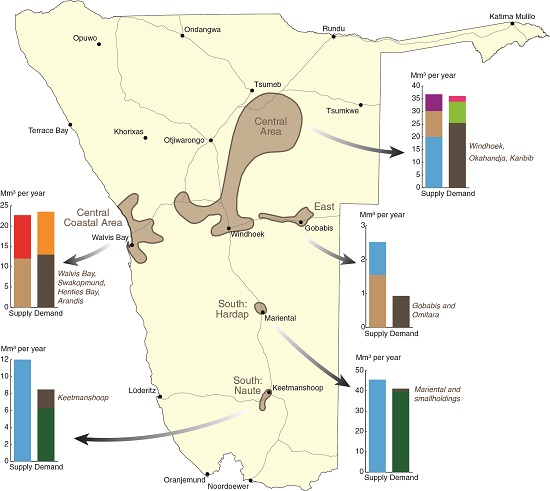Water demand
Demands on water steadily increase as Namibia's population and industrial, agricultural and service sectors grow. Meeting these needs in a country as dry as Namibia requires the development and use of a range of different sources, management strategies and innovative methods to harvest, conserve, treat and reuse water. An additional challenge comes from the substantial recent increase in urbanisation, to which Namibia has yet to become accustomed. However, water supplies focused on these centres of growth and development can be provided more economically and effectively than those in rural areas, and urban-based economic activities usually give a higher return per cubic metre of water than those in rural areas.
4.19 Water demand by sector, 200821
From an estimated 334 million cubic metres in 2008, Namibia's total water consumption is expected to more than double to 772 million cubic metres by 2030. Irrigation is by far the largest water user, accounting for more than 40 per cent of use in 2008, followed by livestock farming (26 per cent) and urban use (domestic, industrial and other use) at 20 per cent, whilst mining accounted for less than 5 per cent of total use.
Different uses of water deliver quite different benefits, however. For example, each cubic metre of water used to irrigate commercial crops is estimated to return N$0.55, but a cubic metre of water used for commercial livestock farming returns N$18. Other uses of water are estimated to produce average returns of N$261 for manufacturing, N$127 for mining and N$552 for services per cubic metre of water.22

Photo: J Mendelsohn
This canal carries water across central-northern Namibia from the Calueque and the Olushandja dams to Oshakati. Water from this canal is treated and then piped across the region to supply about 35 per cent of Namibia's population, as well as enterprises and services in several major towns (figure 4.21).
4.20 Matching supply and demand23


Namibia's aridity and its battle to supply water to its widely distributed population is well known. However, the struggle is most difficult in certain areas, especially in and around urban centres where the demands for water increase rapidly and supplies may fluctuate or be inadequate. This map focuses on five areas where supply and demand is hardest to match in the long term.
Surface and groundwater sources cannot sustainably satisfy demands in the Central Area indicated on this map due to years of drought and increasing needs for water. Such circumstances require the reuse of water, the acquisition of water from elsewhere, reductions in demand, and/or water-saving measures.
At the time of publishing this atlas, urban demands in the Central Coastal Area slightly exceeded yields from the Omdel and Kuiseb aquifers. Desalinated seawater makes up the deficit, and also supplies all the water used by the uranium mines in the area. In the longer term, it is expected that water reuse and additional desalination of seawater will dominate supply in this area.
Whilst groundwater sources could meet the East's urban demands in Gobabis, dammed surface water is supplied first when it is available to maximise its use before it is lost to evaporation. Groundwater is thus conserved for later use and for local farmers reliant on it. Demands can therefore be met from different supplies at different times, but only if rainfall provides adequate amounts of surface water.
Water consumption for irrigation is considerably higher than other uses in the South in both the Hardap (Mariental) and Naute (Keetmanshoop) supply areas. While these areas may not appear to be water stressed, water shortages do occur when rainfall and runoff is low in the catchment areas of the two dams. How supply and demand will change when Neckartal Dam (figure 4.22) and its associated irrigation scheme become fully operational remains to be seen.

Photo: P Mostert
A relatively unlimited, but expensive, supply of desalinated water is available on the coast. This is the Erongo Desalination Plant 35 kilometres north of Swakopmund, and the first of its kind in Namibia.


